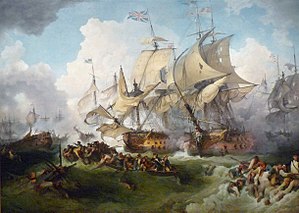The Glorious First of June
| Glorious First of June | |||||||
|---|---|---|---|---|---|---|---|
| Part of the French Revolutionary Wars | |||||||
 Lord Howe's action, or the Glorious First of June Philippe-Jacques de Loutherbourg, 1795 |
|||||||
|
|||||||
| Belligerents | |||||||
|
|
|
||||||
| Commanders and leaders | |||||||
|
|
|
||||||
| Strength | |||||||
| 25 ships of the line | 26 ships of the line | ||||||
| Casualties and losses | |||||||
| 1,200 casualties | 6 ships of the line captured, 1 ship of the line sunk, ~ 4,000 casualties 3,000 captured |
||||||
The Glorious First of June (also known in France as the Bataille du 13 prairial an 2 or Combat de Prairial)[Note A] of 1794 was the first and largest fleet action of the naval conflict between the Kingdom of Great Britain and the First French Republic during the French Revolutionary Wars.
The action was the culmination of a campaign that had criss-crossed the Bay of Biscay over the previous month in which both sides had captured numerous merchant ships and minor warships and had engaged in two partial, but inconclusive, fleet actions. The British Channel Fleet under Admiral Lord Howe attempted to prevent the passage of a vital French grain convoy from the United States, which was protected by the French Atlantic Fleet, commanded by Rear-Admiral Villaret-Joyeuse. The two forces clashed in the Atlantic Ocean, some 400 nautical miles (700 km) west of the French island of Ushant on 1 June 1794.
During the battle, Howe defied naval convention by ordering his fleet to turn towards the French and for each of his vessels to rake and engage their immediate opponent. This unexpected order was not understood by all of his captains, and as a result his attack was more piecemeal than he intended. Nevertheless, his ships inflicted a severe tactical defeat on the French fleet. In the aftermath of the battle both fleets were left shattered; in no condition for further combat, Howe and Villaret returned to their home ports. Despite losing seven of his ships of the line, Villaret had bought enough time for the French grain convoy to reach safety unimpeded by Howe's fleet, securing a strategic success. However, he was also forced to withdraw his battle fleet back to port, leaving the British free to conduct a campaign of blockade for the remainder of the war. In the immediate aftermath both sides claimed victory and the outcome of the battle was seized upon by the press of both nations as a demonstration of the prowess and bravery of their respective navies.
...
Wikipedia
